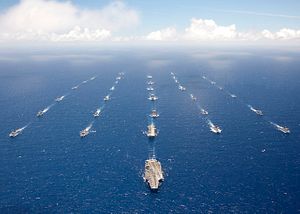For several years now, Pentagon officials have insisted that the world is returning to an era of “great power competition.” Pentagon budgets prioritizing a bigger fleet, new bombers, advanced new long-range and high-speed missiles, and even 1,000-mile super-guns are all aimed at maintaining an overwhelming military advantage over Russia’s, but especially China’s burgeoning military. But even before the COVID-19 pandemic hit, many of these projects faced uncertain budgetary paths. Afterwards, both China and the United States will require extraordinary economic and social recovery efforts that may leave defense budgets under greater pressure than in decades.
China’s navy has grown at an incredible pace over the last two decades, from a largely coastal force comprised of old Soviet designs to the world’s second largest blue-ocean fleet. But alongside projections that it will keep growing apace for the next 10 to 15 years, there are other signs it may be leveling off soon as budget pressures mount. Chinese reports also suggest that the infrastructure on its massive artificial island bases in the South China Sea was hastily constructed in a challenging climate and is already beginning to fall apart, raising doubts about the islands’ ability to project advanced military force in a high-end conflict.
And now China must recover from the pandemic that started in Wuhan over the winter. By some estimates China’s GDP shrank more than 10 percent in the first two months of the year. The economic shutdown caused by the pandemic has brought work and investments in China’s marquee Belt and Road Initiative projects to a halt, and experts question whether all those projects will ever be restarted. That also raises doubts about the prospects for many new ones.
On the other side of the Pacific Ocean, the U.S. Navy has been trying to figure out how to get to the 350-ship fleet advocated by President Donald Trump since the 2016 election, but remains stymied by rising costs, shipbuilder capacity, and the ability to recruit and train enough additional people to crew a substantially bigger fleet. One stopgap proposal to increase the size of the fleet was to extend the service lives of its older Arleigh Burke-class destroyers, but the Navy now believes this solution is likely uneconomical and too short term. But the plans to design a follow-on class to gradually replace the aging Burke fleet have been slow to develop and so far appear too expensive. The secretary of defense has said he is committed to building a larger fleet but also cut the Navy’s shipbuilding budget by 20 percent in his proposed 2021 budget. Meanwhile Navy leaders have told Congress that building a 355-ship fleet would require increasing the annual shipbuilding budget by nearly 50 percent each year for the next decade.
But the fiscal situation for the force the Pentagon asserts it needs to meet the threat of China’s military was this dire even before the United States began taking drastic measures to prevent the spread of coronavirus and its economic consequences began to take shape. The Dow Jones Industrial Average has lost nearly a third of its value in the last month and saw its second largest one-day drop in history on Monday. The Treasury Department has estimated unemployment in the United States could reach 20 percent during the pandemic without extreme measures, twice the rate at the height of the 2008 financial crisis. The likelihood that next year’s Pentagon’s budget will bear much resemblance to what Congress was briefed on over the last several weeks is probably now quite low.
Thus far during the pandemic crisis, relations between the United States and China have deteriorated. Chinese diplomats have attempted to spread awkward conspiracies that the virus is somehow the fault of the United States and China is now expelling journalists from the New York Times, Washington Post, and Wall Street Journal. The two countries may emerge from their respective coronavirus crises with greater antipathy than the relationship has seen in decades, but also with substantial repairs to make to their societies and economies, and perhaps with less capacity to do harm to each other than either planned in coming years.

































